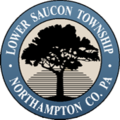17th century
Until the mid-17th century, Lenape Native American tribes hunted and inhabited the land of Lower Saucon Township. European traders first arrived in the area in the 17th century, and the Lenape peacefully traded with them with the exception of several periodic skirmishes. William Penn, who later founded the colonial-era Province of Pennsylvania, one of the initial Thirteen Colonies, was granted land on March 4, 1681, by King Charles II to repay a debt owed to Penn's father, a Royal Navy officer of the same name.
The land grant included what is now Lower Saucon Township. However, Penn soon realized that he needed to purchase the land from the Native Americans to maintain clear ownership. Penn advertised throughout Europe, offering 100-acre (0.40 km2) parcels of land for 40 shillings, subject to a rent of one shilling per annum forever.
18th century
In 1737, Penn's sons expanded their land holdings through the Walking Purchase to include most of the Lehigh Valley. Although the Lenape did not think this was a legitimate claim, they eventually moved out of the area, allowing Europeans to settle it. Sometime before 1737, Nathaniel Irish established a farm, built a grist and saw mill, and opened a land office for William Penn. He is considered the first European settler in Lower Saucon Township. Irish was the first justice of the peace in the area, and the first King's Highway, from Philadelphia to the Lehigh Valley, built in 1737, led to his property. His son, also named Nathaniel Irish (1737-1816), built Nathaniel Irish House in Philadelphia.
Lower Saucon Township was chartered in 1743, when it was still a part of Bucks County. It was established in the rich farmland along Saucon Creek. The name Saucon comes from the native Unami language word sakunk, meaning “at the mouth of the creek.” [3] The township also included South Bethlehem until 1865 and Hellertown until 1872.
German immigrants, convinced by Penn's favorable description of the New World, settled Lower Saucon Township in large numbers, beginning in the 1730s. Some of the surnames of the early German settlers were Boehm, Wagner, Appel, Riegel, Brunner, Lerch, Laubach, Oberley, Heller, Shimer, and Lutz. These early settlers were hardworking, and their farms prospered. There were numerous mills built to provide sawed wood, flour, textiles, paper, and gunpowder. Other early industry included lime kilns and the extraction of zinc and iron ore.
During the Revolutionary War, many German farmers enlisted in the Continental Army to fight the British. At a time when the Continental Army's reserves were depleted, they offered to sell wheat and rye on credit. In 1777, soldiers of the Continental Army transporting the Liberty Bell to Allentown, passing through Lower Saucon and spending a night in Leithsville. The Marquis de Lafayette stopped at Wagner's Tavern in Hellertown on his way to Bethlehem during the Revolutionary War.
The first church, Lower Saucon Church, was established in 1734, soon after the early settlers' arrival. It was built by a German Reformed congregation on what is present-day Easton Road. There were ten schools in the township, established by local church congregations, before the Pennsylvania state legislature developed the state's public school system in 1834.
20th and 21st centuries
Lower Saucon Township was impacted by the late 20th century downturn and eventual closure and bankruptcy of Bethlehem Steel, which was the second-largest steel manufacturer in the world for most of the 20th century. Bethlehem Steel executives purchased farmland in Lower Saucon Townships and built large estates in the township, and the steel company became the largest employer in the Lehigh Valley region. It underwent a substantial reduction in manufacturing in 1982 and ultimately ceased manufacturing entirely in 1995, resulting in the termination of employment for many township residents.
Four locations in Lower Saucon Township have been named to the National Register of Historic Places: Ehrhart's Mill Historic District, Michael and Margaret Heller House, Lutz-Franklin School, and Northampton County Bridge No. 15. [4]






